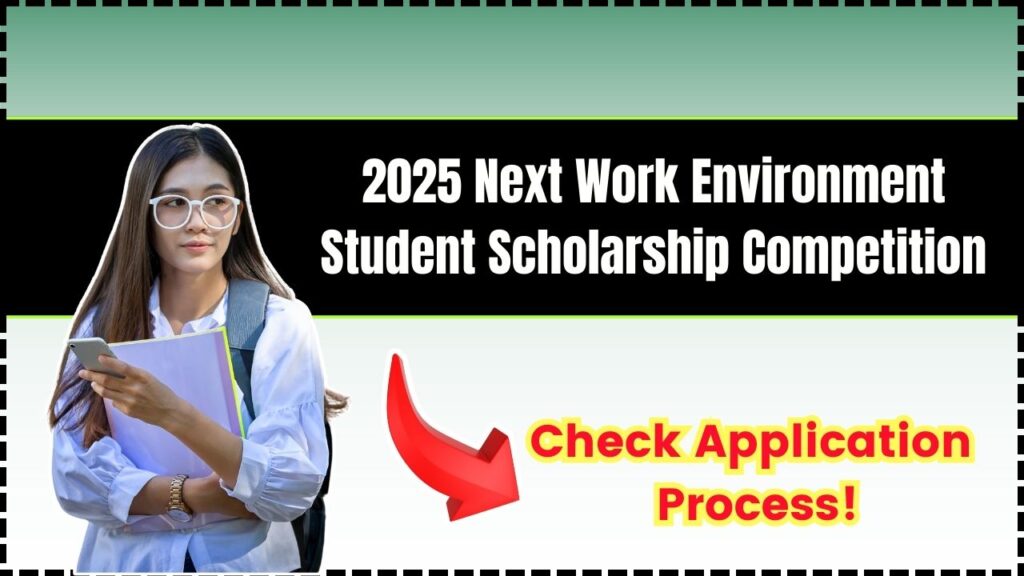2025 Next Work Environment Student Scholarship Competition: The 2025 Next Work Environment Student Scholarship Competition is an exciting opportunity for students worldwide to showcase their innovative ideas on the future of workspaces. Organized by Work Design Magazine, this competition invites young minds to reimagine workplaces with fresh, forward-thinking solutions.

Whether you’re an undergraduate, graduate, or design enthusiast, this competition is your chance to gain recognition, win scholarships, and contribute to shaping the next generation of workplaces. With workplaces evolving rapidly due to technological advancements and shifting workforce dynamics, there is a pressing need for new and sustainable work environments. This competition encourages students to think outside the box, propose practical solutions, and bring their visions to life.
2025 Next Work Environment Student Scholarship Competition
| Feature | Details |
|---|---|
| Competition Name | 2025 Next Work Environment Student Scholarship Competition |
| Organizer | Work Design Magazine |
| Eligibility | Undergraduate and graduate students, 18+ years old |
| Entry Type | Individual or teams (up to 3 members) |
| Submission Deadline | April 25, 2025 |
| Finalist Announcement | May 6, 2025 |
| Grand Prize | $1,500 scholarship + Paid trip to IFMA’s World Workplace 2025 |
| Additional Prizes | Cash prizes start from $500 |
| Official Website | Work Design Magazine |
The 2025 Next Work Environment Student Scholarship Competition is an incredible chance to showcase your creativity, problem-solving skills, and vision for the future of work. With scholarship opportunities, career networking, and industry recognition, this is the perfect platform for students looking to make an impact.
What Is the 2025 Next Work Environment Student Scholarship Competition?
This competition challenges students to rethink the traditional office, hybrid, and remote workspaces to create solutions that improve productivity, collaboration, and sustainability.
Participants can choose from different categories that focus on aspects like flexible workspaces, technology integration, and well-being-driven environments. The competition isn’t just about design—it also values research, functionality, and innovative problem-solving. With the increasing demand for hybrid work models and smart office solutions, this event provides students a chance to propose ideas that align with modern business needs.
Why Should You Participate?
Participating in the 2025 Next Work Environment Student Scholarship Competition comes with multiple benefits, including:
- Scholarship Prizes: Winners receive cash prizes starting at $500, with the grand prize winner earning a $1,500 scholarship.
- Career Advancement: Gain recognition from industry leaders, designers, and top organizations.
- Networking Opportunities: Connect with professionals, potential employers, and innovators in the work design space.
- Resume & Portfolio Boost: Winning or being a finalist stands out on resumes and can lead to job offers and internships.
- Real-World Impact: Your ideas could influence how companies design their work environments.
Categories & Competition Guidelines
The competition is divided into four main categories, each addressing a different aspect of workplace innovation.
1. Workplace
Challenge: Design a future hybrid workspace that encourages productivity and accommodates different work styles.
Example: A flexible office that shifts between remote workstations, collaboration zones, and quiet spaces depending on an employee’s needs.
2. Experiential
Challenge: Create an environment where amenities and experiences enhance productivity and well-being.
Example: Offices with meditation pods, gaming zones, or AI-driven lighting systems that adapt to employee moods to reduce stress and increase focus.
3. Pick a Problem
Challenge: Identify a specific workplace issue and propose a solution.
Example: Sustainable commuting solutions, ergonomic furniture, or AI-powered HR tools that improve employee engagement and retention.
4. Third Place
Challenge: Develop a non-traditional workspace beyond offices and homes.
Example: Co-working cafes, shared green spaces, or interactive virtual work environments that offer flexibility and creativity to remote workers.
How to apply for 2025 Next Work Environment Student Scholarship Competition
Step 1: Prepare Your Submission
Your submission should include:
- Contact Information: Name, email, phone, school, and graduation year.
- Project Name & Description: A 500-word summary of your concept, explaining its impact and functionality.
- Supporting Materials: Up to 10 images (JPEG) or 10 slides (PowerPoint, Canva).
- Optional Video: A 7–30 second clip showcasing your concept (max: 3 minutes).
Step 2: Submit Your Entry
- Visit the official Work Design Magazine competition page.
- Upload your project materials and double-check submission guidelines.
- Ensure your submission is formatted correctly and follows all rules.
Step 3: Await Finalist Announcement
- The top finalists will be announced on May 6, 2025.
- Finalist calls with jury members will take place on May 16, 2025.
- Winning ideas will be featured on WorkDesign.com in June 2025.
- Selected finalists will have an opportunity to present their ideas to industry experts.
Jiangsu University’s China Link Scholarship 2025 – Check How to Apply and Eligibility Criteria!
FAQs about 2025 Next Work Environment Student Scholarship Competition
1. Who can participate?
Any undergraduate or graduate student aged 18 or older can enter, either as an individual or in teams of up to three.
2. Is there a participation fee?
No, entry is free for all students.
3. Can I submit more than one project?
Yes, but each entry must be unique and submitted separately.
4. What happens if I win?
Winners will receive scholarships, recognition, and networking opportunities. The overall winner gets a paid trip to IFMA’s World Workplace 2025.
5. How will my project be judged?
Entries are judged on innovation, functionality, impact, and feasibility by industry experts.
6. What makes a strong submission?
A compelling entry should be well-researched, visually appealing, and provide a practical yet innovative solution to a workplace challenge.








